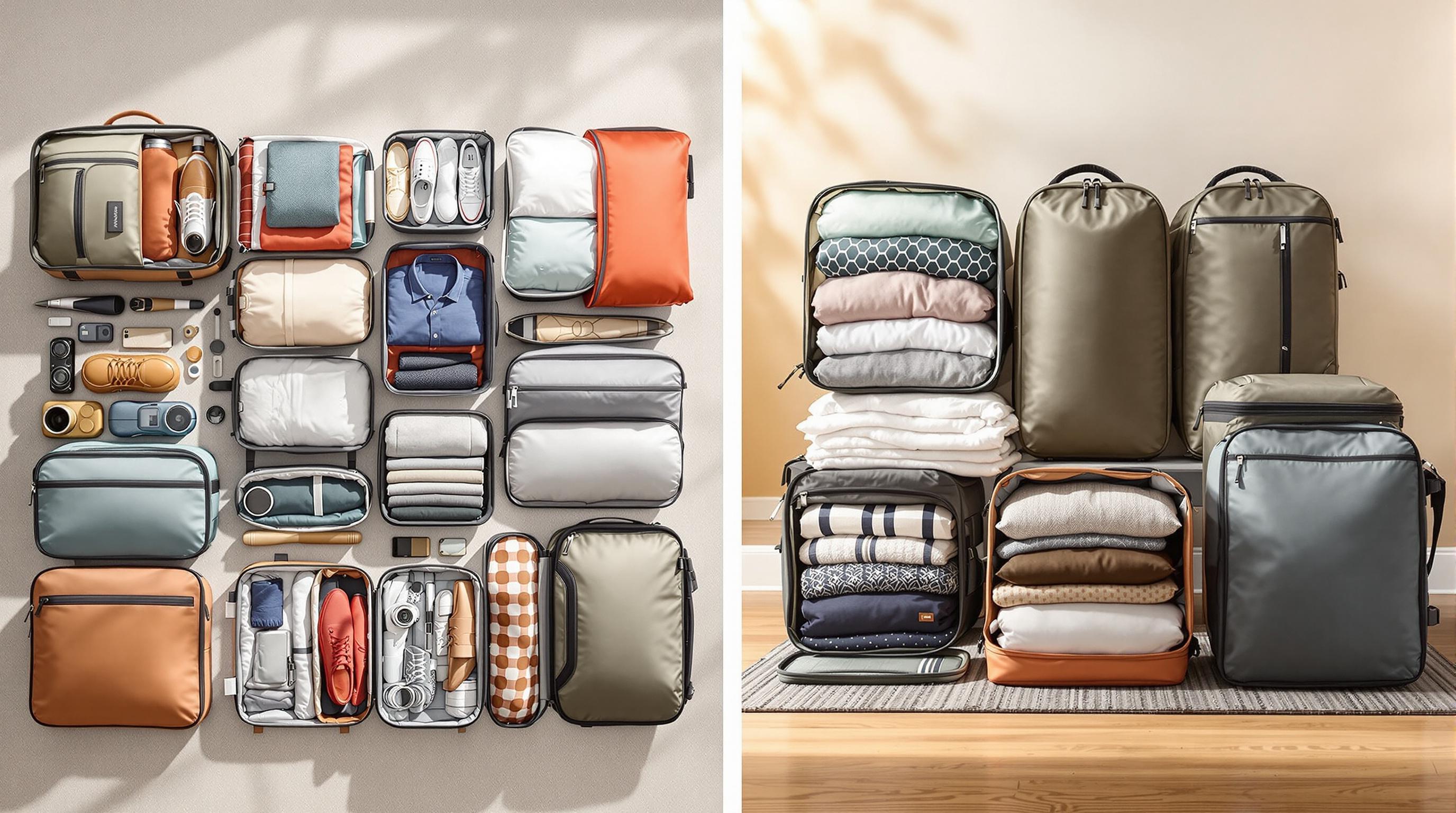Packing modules and compression bags serve different purposes for travelers. Packing modules help you stay organized by separating items into compartments, while compression bags save space by vacuum-sealing soft items like clothing. Here's a quick breakdown:
- Packing Modules: Great for organization and quick access. Think of them as portable drawers for your suitcase.
- Compression Bags: Focus on saving space by squeezing out air, ideal for soft items like clothes and bedding.
Quick Tip: Combine both systems for maximum efficiency - use compression bags for clothes and packing modules for essentials.
| Feature | Packing Modules | Compression Bags |
|---|---|---|
| Purpose | Organization and accessibility | Space-saving by air removal |
| Best For | Electronics, accessories, etc. | Clothes, bedding |
| Ease of Access | High | Low (requires unpacking) |
| Material Durability | Reinforced nylon/polyester | TPU-coated nylon |
| Weather Protection | Water-resistant | Fully waterproof |
Choose based on your trip needs - organization, space-saving, or both!
How They Work Differently
Storage and Access
Packing modules and compression bags handle storage in distinct ways. Packing modules focus on keeping items organized with structured compartments, making it easy to grab what you need without unpacking everything. Think of them as portable drawers for your luggage.
Compression bags, on the other hand, save space by vacuum-sealing soft items. However, this bundling approach makes it harder to access individual items quickly.
Space-Saving Methods
Packing modules maintain their shape and volume through compartmentalized storage. In contrast, compression bags shrink items by removing air. This is done either with a pump or by rolling the bag to push out the air.
Best Items for Each System
Compression bags work well for soft, lightweight clothing when space is limited. Packing modules are ideal for travelers who prioritize staying organized and want quick access to their belongings.
Packing Cubes vs. Compression Packing Cubes: Are They ...
Materials and Build Quality
The durability of travel gear largely depends on the materials used and how well it's constructed - especially for long trips.
Material Types and Durability
Most packing modules are made from reinforced nylon or polyester, which helps them keep their shape and protect your belongings. Compression bags, on the other hand, often use TPU-coated nylon or laminated fabrics. These materials are tough enough to withstand the wear and tear that comes with squeezing out excess air.
Protection Against Weather
Packing modules are designed to handle minor weather challenges with water-resistant zippers and PU-coated fabrics that repel splashes. Compression bags go a step further, featuring fully waterproof TPU layers and sealed valves to keep your items dry. A good example is the Atlas Vault, which uses these features to block out moisture effectively.
What Travelers Are Saying
Users often highlight the Atlas Vault for its sturdy materials, well-thought-out compartments, quick shipping, and efficient vacuum pump. Its solid build and ability to handle different weather conditions make it a reliable choice for multi-destination trips - a topic we’ll dive into next.
sbb-itb-b1567d8
Long-Term Travel Performance
When it comes to extended trips, the durability of materials and storage methods plays a big role in how well a system performs on the road.
Multi-Stop Travel Use
Hard-sided packing modules keep your belongings organized, allowing you to grab what you need without disrupting everything else. On the other hand, compression bags help save space but require more effort each time you unpack or repack. Travelers often highlight products like the Atlas Vault, which combines vacuum compression with built-in compartments for better organization.
Travel Rules and Size Limits
Airlines are frequently tightening carry-on size restrictions, so sticking to the limits is essential. Packing modules, with their fixed shapes, generally fit into approved dimensions more easily. In contrast, compression-style bags can bulge if overstuffed, potentially leading to size-check issues.
Vacuum-compression backpacks usually meet carry-on requirements, but there’s a catch. For example, one traveler noted that while the Atlas Vault maximizes packing space, it can sometimes exceed strict airline size limits when fully compressed [1].
Weight and Ease of Use
Weight is a key factor for comfort, especially during long trips. Compression systems add extra capacity but also come with additional components - like vacuum pumps and extra compartments - that increase the pack's overall weight. In contrast, packing modules are simpler and lighter since they don’t rely on mechanical parts. If you're considering a vacuum-compression system, weigh the added features against the need for portability on extended journeys.
Picking the Best Option
Now that you’ve reviewed how each system performs over time, it’s time to choose the one that fits your trip’s needs. Consider factors like trip length, the type of items you’re packing, available space, and carry-on restrictions.
Key Decision Points
- Packing modules: Great for keeping structured items organized and easy to find. However, they come with a fixed capacity.
- Compression bags: Ideal for reducing the size of soft items like clothes, saving the most space in your luggage.
Using Both Systems Together
For the best of both worlds, try combining the two. Use compression bags for soft items like clothing to save space, and rely on packing modules to keep everyday essentials neatly organized. Adjust the mix based on your specific needs to strike the right balance between staying organized and maximizing space.
Conclusion
Compression bags are perfect for cutting down the bulk of soft items, making them great for long trips where saving space is key. On the other hand, packing modules focus on keeping things organized and easy to access throughout your travels.
When deciding, consider airline size restrictions, what you're packing, and how often you'll need to unpack. If you're looking for a combination of space-saving and organization, the Titantrek Atlas Vault backpack offers vacuum compression, waterproof protection, and a TSA-approved lock.

TSA-Approved Backpacks with Vacuum Compression
How Waterproof Coatings Protect Travel Gear